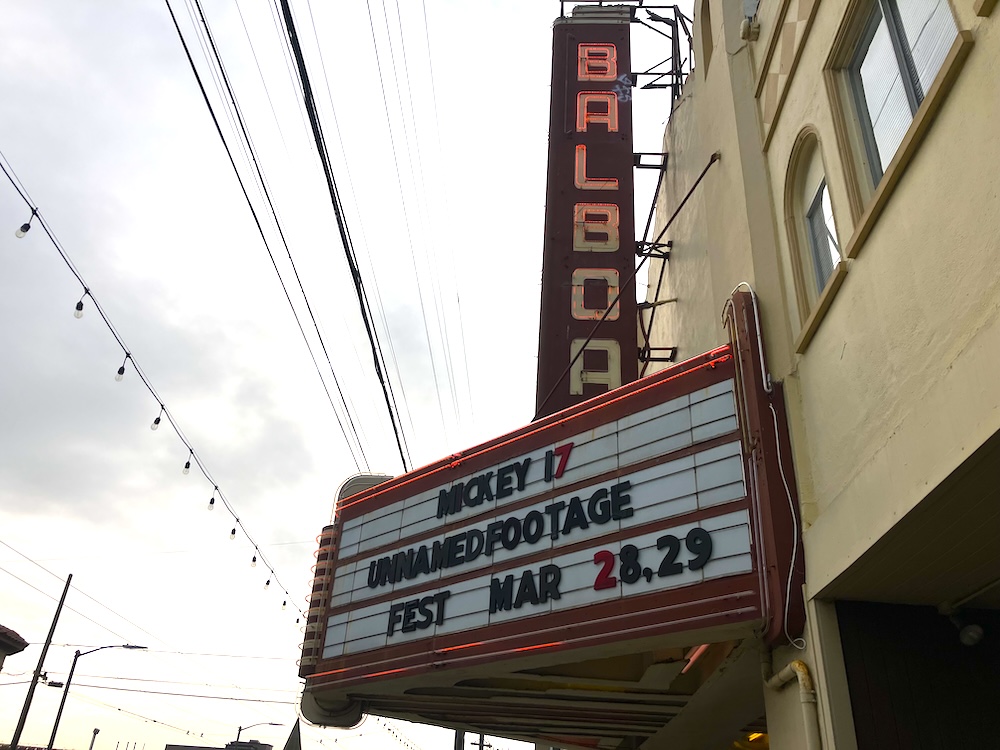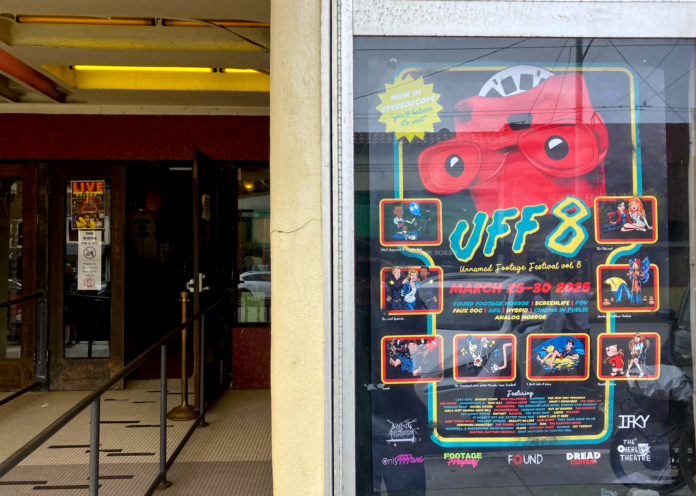When I was first introduced to the Unnamed Footage Festival last year, the event had a whiff of crossover about it. The festival, which took place this year March 25-30 at 4 Star Theater, celebrates the genre broadly referred to as “in-world camera,” most famously including the found footage genre of horror (i.e., “a year later, this footage was found”) and broadly, cousins like screenlife, in which the action takes place on a computer screen, i.e. Unfriended, and analog horror, which finds the ghosts in obsolete physical media, i.e. Skinamarink.
This latter film, and other recent successes like Robbie Banfitch’s Outwaters and Jane Schoenbrun’s We’re All Going to the World’s Fair point to new and interesting directions in a genre that spent much of the aughts being reviled thanks to cheap and easy imitators of found footage’s most famous product, The Blair Witch Project. The Outwaters screened at last year’s Unnamed Footage Festival alongside Anthony Cousins’ Frogman, which had gone viral for its fantastic poster (“the croaks are no hoax!”). To be there, among these young directors and fans, felt like being on the precipice of something big.
Yet, what most struck me this year was how tight and insular the found-footage community felt. These people had forged bonds long before bandwaggoners like myself started looking to low-budget shaky-cam horror to find the next most vital thing in film.
This year’s festival boasted the highest-attended film in the entire history of UFF. That was thanks to Robbie Smith’s I Don’t Like It Here, whose popularity had little to do with any apparent tendrils reached out to the other side of horror fandom and more to do with the fact that everyone involved in its making had been involved in UFF in some way.
And despite the festival opening with a screening of Koji Shiraishi’s 2005 masterpiece Noroi, one of the greatest and most ambitious films ever made in the genre, the general gist of the 11 films I saw this year was of people trying to have fun rather than trying to make art. With the exception of Banfitch’s spectral Tinsman Road, none of the films I saw was especially high-minded or ambitious. They instead reflected a scrappy sense of community, content to circulate within the tight-knit festival circuit rather than be the next Blair Witch.
The first day I was able to attend was Friday. I heard good things about Dream Eater, which screened earlier in the day, but I arrived mid-afternoon for Alex Hera’s What I Remember, which isn’t much of a horror film at all. Shot as a video diary by a trans woman named Rachel as she navigates her transition in a small and closed-minded town, What I Remember spoke more eloquently through its zero-fi Days of Heaven cinematography than the performances of the actors, who seem to have received little direction and talked with the forced enthusiasm of community-theater players.
Another queer-themed film followed, The Rebrand, where a young documentarian helps a disgraced lesbian influencer couple get their groove back and finds herself in a sinister hothouse of self-help psychobabble and passive-aggressive tenderness. I admired its willingness to call the queer community on its own shit, not least the tendency to couch selfish and vindictive behavior in the language of equity and positive thinking, but it remained strictly in the realm of horror comedy, and it floated away like a feather after I saw it.
Tinsman Road was my most anticipated film at the festival. I loved Banfitch’s other movie The Outwaters, with its phantasmagoric trip through the desert, but if that film’s extended denouement (shot in the light of a single flashlight beam) felt like its director ripping a 40-plus-minute free-jazz sax solo, Tinsman Road played like a low note from a dented horn. Much of it is a two-hander between Banfitch and his mother Leslie Ann, an excellent actor who, on the basis of her acting in her son’s films, could excel in the kind of weary and beleaguered roles Danielle Deadwyler has been making her own lately.
Help us save local journalism!
Every tax-deductible donation helps us grow to cover the issues that mean the most to our community. Become a 48 Hills Hero and support the only daily progressive news source in the Bay Area.
We learn about a disappearance in the family, about strange goings-on at Tinsman Road, and as in The Outwaters, we get an extended outdoor sequence that feels like a voyage into the mouth of hell. I was initially frustrated by the film’s lack of a payoff and unwavering focus on grief and familial guilt, but its cold touch lingered in my head after it ended, and I was eventually forced to confront that it was one of the festival’s best films.
***
The first film I saw Saturday was also a new effort from a filmmaker who’d been featured last year. David M. Dawson is an exciting talent, and his muse seems to be the darkest depths of YouTube, where lonely and desperate losers scream into the void in search of their 15 minutes of fame. Last year’s Flesh Games followed a group of Jackass imitators to desperate extremes and featured copious scenes of actual shitting and vomiting, with only the blood confirmed to be fake.
Leech, the tale of a YouTube streamer driven to increasingly transgressive acts to solicit donations from his fans, is even harder to watch. We see its hero consume a can of cat food, a dead rat, and a concoction of chicken nuggets swimming in soda and hot sauce, and the low fidelity of these dispatches makes it no less easy to imagine the smell in the room. I will probably never see it again, but if you’re the kind of person who seeks out midnight screenings of Pink Flamingos, I can feel comfortable telling you that Dawson’s is a name to watch.
I found Johannes Grenzfurthner’s Solvent just as difficult to sit through, but for different reasons. The film follows a former mercenary played by Jon Gries (Uncle Rico in Napoleon Dynamite) as he seeks old Nazi documents from the home of an Austrian fascist who recently died—or did he? He seems to be present in the very earth, which of course is a metaphor for how hatred still stains the soil, nothing you couldn’t glean from pulling up the headlines.
Serious subject matter indeed, and yet the acting in the film was pitched at a sort of maniacal Dr. Strangelove parody of wheedling European madness, with the exception of Gries, who was nonetheless utterly unconvincing as a man who ostensibly had murder on his conscience. After a while, the clown act became grating enough that I started to think of Jojo Rabbit, Life is Beautiful, and Jerry Lewis’s unreleased film The Day the Clown Cried. This kind of quirky thrashing is obnoxious enough when it’s not set to the backdrop of one of the most debased events in human history.
Then came It Doesn’t Get Any Better Than This, which I think most epitomized the spirit of the movies I saw this year, even if it was far from the best of the lot. It’s the record of a perfectly adorable couple, played by the couple who made the film, Nick Toti and Rachel Kempf. They’re horror nerds, rarely seen without a shirt celebrating some campy giallo flick from the past, and they’ve bought a creepy old house to fix up and use as a home and filming location.
They’re thrilled by the Satanic graffiti strewn everywhere, even more so when lights start going on and off in the attic and a creepy mural appears that Nick and Rachel swear neither of them painted, even though it looks like exactly the kind of thing two horror geeks would add to their home. The film feels like a celebration of the cuteness of their couplehood, and if not for all the ominous Satanic signs it could be taken for a Netflix home-renovation special. I Don’t Like It Here was the last movie I saw on Saturday, though the event extended into the wee hours of the morning.
***
Sunday at the 4 Star kicked off with Jeremy Brothers and Nick Paonessa’s McCurdy Point, which I found interesting because the victims were older than usual. The main characters are all straight men in their 30s and 40s: beery, jovial dudes who might’ve been high school football stars in their youth, the type to convince themselves that if Jason ever came knocking at their door, they’d put him under with a baseball bat quick enough.
Yet they’re no match for the mysteries of McCurdy Point, a secluded Maine cove where they’ve rented a cabin for the weekend from a local weirdo whose rambling stories veer from folksy to disturbing (“you should do a podcast,” one of the city slickers tells him). The movie is a bit inconsistent about what those mysteries actually are, and the frosty expanse of Maine itself is underused for its horror, but it gets great mileage out of the rumblings that happen in the cabin in the middle of the night.
Next came Fat Tuesday by Jorge Torres-Torres, a name I’d never heard of but whose list of fairly obscure credits was enough to make him something of a legend in this crowd (the only one I’d heard of was Jason Banker’s great 2011 film Toad Road, which he edited). Fat Tuesday wasn’t really found footage but part of another subgenre, “cinema in public,” which incorporates real events that are actually happening into its narrative. In this case, the camera follows a serial killer as he slashes her way through a group of drunken Mardi Gras revelers in New Orleans.
All the action was filmed during Mardi Gras proper, and all the floats we see are real. Remarkable, given this guerrilla form of filmmaking, is the dreamlike quality it took on. The killer seems otherworldly, like the trophy-hunter in Predator or the succubus in Under the Skin, and though it’s sad that she gets away with dispatching so many people we grow to like, there’s something about the way she does her work and drifts on free of consequences that feels intriguingly alien.
Hunting Matthew Nichols was the third film I saw on Sunday, and maybe the best I saw during the entire festival. The protagonist is investigating the disappearance of her brother, which may have something to do with a local Blair Witch-like hermit who lives in the woods of Vancouver Island in foggy British Columbia. The story of the hermit turns out to be a cover for something much worse, and the film is sly in its misdirection.
Early in the film, the protagonist receives a crucial piece of video evidence, and we have a pretty good idea of what it shows—yet director Markian Tarasiuk doesn’t actually share its contents until the end. Once we see what it actually contains, it throws the protagonist’s quest to find her brother in a completely new light. It also includes a subtext relating to Canada’s treatment of its Indigenous population that I found to be a far more purposeful commentary on the stain of racism than anything Solvent had to say.
Wrapping up was What Happened to Dorothy Bell?, the last film of the festival, where a young woman confronts the knowledge that her grandmother may have been involved in occult deviousness and may still haunt the library where she worked during her life. It’s made very clear in the first 20 or so minutes of the film that she was and she does, robbing the film of much of its suspense even despite some good scares.
Had the hero only taken one trip to the library, it might’ve been scarier. As it is, she keeps coming back, the ghost keeps making its presence inescapably known, and you’d think she’d only need one visit to submit indisputable proof of the existence of ghosts to the authorities. Watching Dorothy Bell reminded me why I find slow-burning horror so much more effective than ones that throw spirits at you left and right.

After Dorothy Bell wrapped up, the revelers made their way to Trad’r Sam’s for tiki drinks and started punching metal songs like Mastodon’s “Blood and Thunder” into the jukebox, which felt appropriate, as did the almost uniformly all-black outfits of the revelers. I’d never been fond of Trad’r Sam’s in the past, being both a tiki snob and an ally of the trans community that I’ve heard is disparaged by patrons almost every time I’ve been in—and yet somehow, the paper umbrellas and unidentifiable rum concoctions filled me with a certain satisfaction.
Not long before the Unnamed Footage Festival, I’d seen Zodiac screen at the 4 Star Theater for a separate event, and there’s a scene where Jake Gyllenhaal and Robert Downey, Jr. visit a bar called Morti’s that’s obviously supposed to be Trad’r Sam’s. They toss back eye-popping electric-blue tiki drinks very much like the ones at Sam’s and discuss confidential matters as they try to crack the case. At that moment, I felt a lot like those characters, part of a secret club.
UNNAMED FOOTAGE FESTIVAL more info here.





